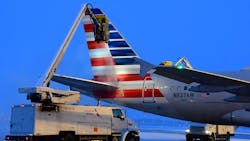American’s Expert Answers the Top Deicing Questions
During the cold and snowy winter months, deicing becomes a critical part of American’s operation. You might be wondering how exactly the airline removes snow and ice from thousands of aircraft each winter to ensure its customers get to their destinations safely and on schedule.
We sat down with Gene Herrick, American’s Manager of Deicing at Chicago O’Hare International Airport (ORD) to find out. Here’s what he had to say:
How does aircraft deicing work? When is it needed?
Gene: Deicing is a really important part of making sure our aircraft can operate safely during winter weather. This is especially true during El Niño winters like this one, where wetter conditions are expected across parts of the United States. Deicing is typically necessary when temperatures are at or below freezing and there is precipitation or frost.
Deicing fluid is sprayed on the wings or other parts of the aircraft and ultimately reduces drag and assists the aircraft with lift as it takes flight. So, in short, deicing ensures the aircraft performs as it should. It’s an art, but also a science. Like all airlines, American follows deicing guidelines published by the Federal Aviation Administration (FAA), Transport Canada (TC) and European Union Aviation Safety Agency (EASA).
What happens throughout the deicing process? How long does it normally take?
Gene: Our team is focused on deicing as quickly and safely as possible to keep our customers and crews moving when winter weather hits. In fact, here at ORD, our goal is to complete the process in nine minutes or less. Depending on the location, each aircraft will be sprayed with fluid at its gate or at a centralized deicing pad after departing the gate. American team members or other airport workers then treat the aircraft with deicing or anti-icing fluid that helps it power through the cold temperatures.
If you’re on an aircraft being deiced, you may see the trucks outside and the fluid on the windows, but otherwise there is no impact to you. Just sit back and relax until take off!
What’s the difference between deicing and anti-icing?
Gene: The short answer is anti-icing is preventive and deicing occurs when snow, ice or other precipitation is already on an aircraft. We use two different fluids, so you may see different colors depending on if we’re deicing or anti-icing. Deicing fluid is orange and is heated to 140 degrees to remove frost, snow and ice off the aircraft and its critical surfaces. Anti-icing fluid is green and keeps ice from penetrating and adhering to critical and lifting surfaces (like the wings). Glycol is the key ingredient in both fluids.
What’s new this winter? How is American improving the process?
Gene: For us, it all starts with training our team. They’re the best in the business. We do this every year, but we’ve added even more training to ensure our team is ready for whatever Mother Nature throws our way. We’re continually making investments to improve our deicing facilities and are also deploying new technology to help us better manage and track our deicing operations — like electronic spray records and tracking tools that give us a better view of and more insight into our airport resources (including deicing trucks) in real-time.
What’s American’s largest, busiest deicing destination?
Gene: My hometown airport, ORD, is our largest location where we deice and one of the busiest in the world when it comes to aircraft deicing. It’s quite an impressive operation! In fact, we deice aircraft 6,000 to 10,000 times per season on average at ORD (depending on the severity of the winter), using approximately 500,000 gallons of glycol.
Is deicing only limited to colder locations?
Gene: Not necessarily. Believe it or not, even warmer regions see a few bouts of freezing precipitation that calls for deicing. We see it at our largest hub at Dallas-Fort Worth (DFW), and also in places like Las Vegas (LAS), Santa Barbara, California (SBA); and Savannah, Georgia (SAV). We’re ready no matter the location!
